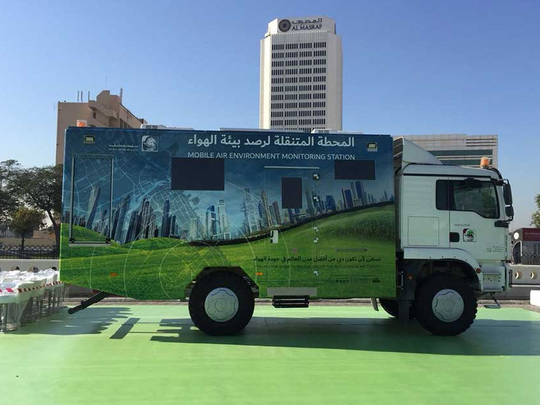
Dubai: The environment-monitoring satellite of Dubai Municipality, DMSAT1, will be completed by the end of this year and will be launched in the second quarter of 2019, the civic body announced on Thursday.
Aliah Abdul Rahim Al Harmoudi, director of the Environment Department at the municipality, said the manufacturing of the satellite, which commenced in July 2017, is continuing as per the schedule.
Al Harmoudi revealed this during her presentation on the latest environment-monitoring systems in Dubai Municipality such as DMSAT1 and the Mobile Environment Monitoring Station during the Dubai International Exhibition for Government Achievements.
It was for the first time that the environmental satellite of the emirate of Dubai was unveiled at the exhibition held this week.
The Mohammad Bin Rashid Space Centre and the municipality had signed an agreement to design and build the region’s first environment-monitoring nanosatellite in December 2016.
Al Harmoudi said it is also one of the latest generations in the global satellite systems.
“It represents an important step towards the future in the field of environment monitoring. The municipality has employed the latest techniques to monitor the air pollutants and greenhouse gases causing the phenomenon,” said Al Harmoudi.
The nanometric environmental satellite has features covering large areas of land and sea, especially as it orbits the earth 14 times per day and re-observes the same monitoring site within five days. The satellite has the ability to provide space data for the monitoring process, even during sandstorms, which are value added given the importance of obtaining such data in such circumstances. It will have two computers — one for ground communication and data storage and the other for sensors and actuators responsible for accurate guidance of the satellite during the monitoring operation. The satellite is powered by solar storage panels. It also contains a GPS system to ensure accurate traffic on specific sites at specific time intervals for monitoring purposes. Thus, it enhances Dubai’s environmental monitoring capabilities to the world’s highest standards.
“One of the most important uses of the environmental satellite is the monitoring and measurement of aerosols in the atmosphere.”
This type of data provided by the satellite is important in the environmental monitoring of the pollutants emitted to the air that threaten the health and safety of the community.
It is also associated with the studies and research on the results of exhaust emissions of vehicles, marine devices, industrial sites and dust.
Therefore, she pointed out, that there is a high possibility to employ such data in the study and analysis of many environmental phenomena, including the growth of moss and red tide, due to the ability of the satellite to cover large areas during the monitoring process.
The satellite will monitor and provide data on the greenhouse gases, which are the cause of climate change, through a secondary loading platform installed on the infrastructure of the satellite, which provides a high possibility to study the nature and magnitude of the effects of climate change in the emirate.
Thus, it will help identify the initiatives, programmes and projects needed to contribute to mitigation and adaptation to this phenomenon, both in relation to the coastal zone and wildlife or natural resources.
Satellite data provided by DMSAT 1 will help develop and correct air quality modelling processes, with the potential to determine the nature of the sources of emissions of air pollutants in the emirate and the extent to which each source contributes to these emissions.
This allows for identifying and taking appropriate control measures to reduce the sources of air pollution.
Data obtained through DMSAT1 will also provide for the aerial correction of the earth parameters observed with remote sensing technology, with the ratio of the concentrations of particulate matter suspended in the upper atmosphere with their observed ratio of earth stations.












